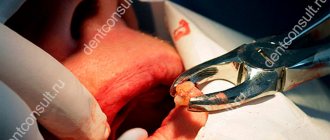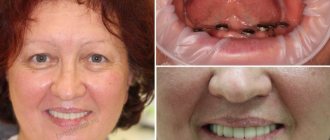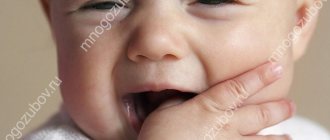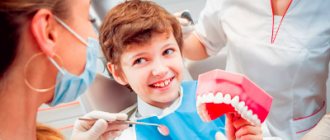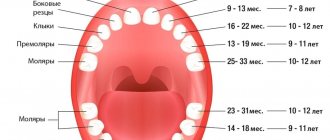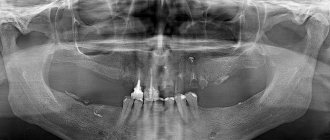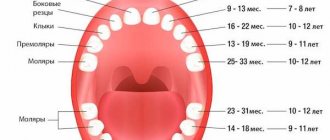The most common dental diseases that a child can develop are caries and pulpitis. However, there are more serious pathologies, and parents need to be aware of them.
One of these diseases is edentia, which is characterized by the absence of teeth. This disease affects both primary and permanent teeth and can develop at any age. There are four main types of edentia:
- depending on the number of missing teeth - complete or partial. The first type is uncommon, diagnosed in only 3-5% of people;
- in accordance with the causes of the disease - primary (congenital) or secondary (arising during life).
Edentia of twos can also occur - the absence of paired front teeth located in the central part of the jaw.
Timing of teething
The wait is especially long after the removal of chewing temporary teeth, which are usually the first to suffer from caries and its complications. Often, parents frivolously insist on removing molar baby teeth, blithely declaring: permanent ones will grow in!
But the process of changing bites develops according to strict laws. Follicles (buds) of temporary and permanent teeth are located in two rows in each jaw of a newborn, going through successive stages of formation and mineralization before eruption. It is impossible to speed up these stages by any means.
The milky roots gradually dissolve, and permanent follicles are pushed out in their place by the coronal part. And only after the formation is completed, permanent teeth appear above the surface of the gum. The first to erupt is the so-called “sixth tooth” - the first molar, which parents often mistake for temporary, and therefore do not treat its carious lesions. This tooth has an important function - it determines the height of the permanent bite and the place of the other “brothers” in the dentition.
We give approximate dates for the appearance of permanent teeth to make it easier for parents to navigate the normality of the change process:
- first incisor - 6-7 years;
- second incisor - 7-8 years;
- fang - 9-11 years;
- first small root - 8-10 years;
- second small root - 11-12 years;
- first major molar - 6 years;
- second major molar - 13-14 years.
Small molars replace primary chewing teeth. If a temporary tooth was removed at the age of 6-7 years, which is not uncommon, then the child is deprived of the ability to fully chew food for as long as 5-6 years. Therefore, it is so important to promptly treat caries of milk precursors.
Types of edentia
Missing teeth and deficient bone volume are often associated with advanced age or traumatic injury. But practice shows that there are several types of such violations.
Primary adentia
A rare pathology associated with improper development of the jaws in a baby. It is detected at the time of eruption of milk teeth or when they are replaced by permanent ones. When there are no rudiments of future teeth in the jaw, the anomaly is called true. In case of developmental delay, late appearance of units (often the crowns overlap each other, merging into a single mass) – false. According to statistics, a birth defect is the frequent absence of crowns from the second to the third chewing molar.
Secondary adentia
This type is acquired, a consequence of severe forms of periodontal tissue diseases, injuries, and somatic ailments. Indeed, a common occurrence in older people. One of the accompanying factors in the development of adentia in this category is the lack of effective and gentle methods of dental care and prosthetics in past decades. The most common types are partial edentia (several units missing) and complete edentia (no teeth at all).
Consequences of early destruction of primary teeth
After the early removal of a baby tooth, the gum in its place becomes overgrown, and the permanent one is deprived of its natural landmark. This leads to phenomena such as:
- dystopia - eruption of a permanent tooth outside the dental arch;
- retention - the occurrence of a formed tooth in the thickness of the jaw bone.
If the baby tooth does not receive treatment, and the inflammatory process spreads to its roots, then the permanent follicle located under them is damaged. In this case, the permanent one may die, and then its place in the dentition will remain empty. The absence of a tooth is confirmed by radiography.
Symptoms of adentia in children and adults
Diagnosis of this disease takes a long time. But there are a number of symptoms indicating its presence. It is especially important to take them into account when determining dental edentia in children. These factors include:
- reduction of jaws (both or just one);
- signs of retraction of the cheeks and lips;
- deformation of the alveolar processes;
- the appearance of wrinkles and folds approximately in the places where the twos are located;
- manifestations of muscular atrophy of the oral cavity;
- change in jaw angles.
All these symptoms can lead to the formation of a malocclusion. Malocclusions, in turn, cause certain shifts of the teeth and the formation of gaps in the jaw. In some cases, growths may form that affect the appearance and make chewing difficult.
Complete secondary adentia can be caused by caries, periodontitis, or surgical intervention. The doctor may also notice scars from injuries that led to tooth loss. Another symptom that explains the loss of masticatory organs is the presence of cancer.
It is worth noting that there is a steady downward trend in the age of edentulous dental patients. Poor ecology leads to the fact that young people are increasingly faced with this problem.
Diagnosis and detection of the disease
Edentia is a serious problem, and to solve it it is very important to promptly and accurately identify the presence of pathology and its type.
The first stage of diagnosis is to conduct a visual examination. Based on the results obtained, the doctor determines whether adentia is primary or secondary.
Then it is necessary to take an X-ray of the jaw, especially if the initial examination showed that the disease is congenital. This can only be confirmed with an x-ray, in which a specialist will check for the presence of dental follicles or identify signs of abnormal development.
When identifying the causes of adentia in children, at the initial stage of diagnosis it is necessary to find out the structure of the root system and find out how things are under the gums. Therefore, in the treatment of childhood adentia, the method of panoramic radiography is used. It allows the doctor to obtain a detailed picture, including information about the structure of the bone tissue of the alveolar processes.
Why is timely diagnosis so important?
Timely detection of adentia is of such high importance for one serious reason. The fact is that before starting any therapeutic actions, it is necessary to diagnose and eliminate all existing pathologies.
First of all, these include inflammatory infections of the oral cavity. During treatment, it is recommended to preserve the roots of the teeth as much as possible, since the absence of roots can lead to the loss of the entire masticatory organ. In addition, it is necessary to carry out complete disinfection of the oral cavity.
If the doctor suspects the development of acquired adentia, it is necessary to find out the cause of the disease as soon as possible. This is due to the fact that some pathologies can lead to complications during prosthetics. To eliminate these risks, the dentist checks for the following symptoms during the examination:
- exostoses (benign growths on bones consisting of bone or cartilage tissue);
- unremoved roots covered with mucous membrane;
- tumors and inflammatory processes;
- infections of the oral mucosa.
Types of adentia and their diagnosis
General symptoms indicating the presence of the disease were discussed above. But there are also a number of signs characteristic of different types of adentia. Their knowledge can also help to identify pathology in a timely manner.
Primary complete edentia
The rarest type of disease and at the same time the most serious. With primary complete adentia, the patient does not even have the rudiments of teeth and their roots. This pathology leads to serious consequences, namely:
- facial symmetry is disrupted;
- the correct formation of the alveolar processes of the upper and lower jaws is difficult;
- the secretion of mucus and saliva in the mouth slows down, which can cause additional inconvenience to the patient.
One of the symptoms of primary complete adentia may be paleness of the mucous membranes. The absence of baby teeth in children can also be easily determined by palpation. If such signs are present, it is necessary to urgently take appropriate measures.
Primary partial edentia
It is expressed in the congenital absence of some teeth in the patient. If partial adentia is detected in a child, the x-ray will show gaps in the root system. It should be noted that the absence of wisdom teeth is not considered edentulous.
As the disease develops, diastemas and tremata are formed - spaces between the chewing organs. In simple terms, the teeth begin to “creep”: if you look at a photo of edentia in children, you will notice large gaps between the teeth.
Primary partial adentia can be symmetrical or asymmetrical. In the first case, there are no paired teeth - doubles or fangs. Asymmetrical adentia means the absence of teeth in different places of the jaw.
Secondary complete edentia
This type of disease is diagnosed when it is acquired. Its symptoms can be observed on all jaws or only on one. Both primary and permanent teeth may be missing. Secondary complete adentia is diagnosed when all the chewing organs have fallen out or needed to be removed due to another disease.
One of the main unpleasant consequences of this pathology is jaw deformation. It becomes closer to the nose, soft tissues begin to retract. Also, this type of disease is characterized by muscle atrophy, leading to disruption of the shape of the entire jaw or one or both alveolar processes.
In addition, the loss of all teeth immediately leads to everyday problems - the patient will not be able to chew independently, and will also begin to swallow some sounds.
Secondary partial edentia
This is the most common type of disease, in which several masticatory organs are missing from the dentition. The loss of canines, twos or other teeth often leads to increased sensitivity of bone tissue. This is due to the gradual wear of the side walls of adjacent teeth.
With this complication, the patient faces discomfort, due to which he gradually stops eating solid food, which is difficult to chew. Both children and adults face this problem.
Possible consequences of edentia
Tooth loss is a serious disease that can lead to various unpleasant consequences, including the development of other serious diseases. Among them are the following:
- impaired jaw development, which leads to difficulty pronouncing various sounds;
- the patient is forced to exclude solid foods from his diet, which causes problems with intestinal motility and disruption of the gastrointestinal tract;
- development of persistent psychological discomfort. The patient’s self-assessment is distorted and depression may develop;
- in the complete absence of teeth, the jaw develops abnormally and can put pressure on any area of the head, thereby provoking the appearance of temporal tumors.
Problems when changing bites
Sometimes a situation arises that a child “grows a tooth under a tooth” - the permanent one has already appeared above the gum, and the temporary one is firmly held in its place. This happens when the resorption process of one or more milky roots is disrupted. This is also a reason to go to the dentist - after all, no one can say how many days later a loose baby tooth will fall out, and its “stubbornness” leads to the dystopia of a permanent one.
Dental doctors remove even such semi-loose teeth with anesthesia, so as not to cause discomfort to children. Only a specialist can decide what to do when changing the bite. Regular monitoring by the dentist during such an important period will help to avoid the formation of an abnormal relationship of the dentition, which will require further treatment by an orthodontist.
If a child’s baby tooth is loose, then you shouldn’t guess how long it will take for it to fall out; it’s better to consult a doctor without delay for qualified advice.
At the Shifa clinic, children are treated with modern equipment using the latest materials. The center has all the conditions for an accurate diagnosis of the condition of primary and permanent dentition, and this is the key to correct medical tactics. The dentists of the Shifa clinic find an approach to every child and master the most advanced methods of assistance, constantly improving their professionalism in Russia and abroad. Contact the best doctors who will help solve any dental problem!
Reasons for the development of edentia
It is difficult to name the exact causes of this pathology, because to date the disease has not been sufficiently studied. According to existing hypotheses, the first manifestations of complete or partial adentia in a child occur during the period of intrauterine development. They are associated with disturbances in the development of the ectodermal layer and the formation of organ roots. Edentia of two can also be caused by endocrine pathologies of the fetus, as well as genetic reasons.
As for secondary adentia, experts identify several variants of the clinical picture of this disease, which is diagnosed relatively often. According to statistics, tooth loss is most often caused by the following factors:
- caries;
- other advanced oral diseases, in particular periodontitis and periodontal disease. Lack of treatment leads to destruction of the masticatory organ;
- other pathologies that cause a general deterioration in the body’s condition. As a rule, they are associated with the functioning of the endocrine and immune systems;
- age-related changes that lead to deterioration in health, including tooth loss;
- hereditary factors
- mechanical injury, for example, a strong blow. In this case, the tooth may fall out either immediately if the main impact was on it, or later if the gums were damaged or the tooth remained in the jaw but was severely damaged. Mechanical trauma is one of the most common causes of adentia, including in children. In a small child, it can lead to developmental defects in baby and permanent teeth.
How can you help your baby?
The main question, what to do if a child has no teeth at 8 months, requires an immediate solution. Therefore, the recommendations in such a situation are clear:
- never cause mechanical damage to the gums yourself;
- Chewing can be stimulated using a special device;
- review the baby’s nutritional issues by discussing them with the pediatrician;
- up to 11-12 months you can monitor the situation - nothing bad happens in the child’s body;
- If there are still no teeth, then you need to see a dentist.
What can a doctor do? Despite the child’s infancy, the doctor will prescribe an x-ray of the jaws. This will help diagnose edentia. In any case, you should always strictly follow the recommendations of the pediatric dentist, who will always try to help the baby.
How does crowded teeth occur?
The development of clinical symptoms is due to the fact that there is not enough space on the jaw for the teeth to take the correct position. This may be due to its insufficient size, too large teeth, their excessive number, or overcompleteness. In adult patients, the development of anomalies is most often caused by pressure on the dentition of the erupting eights, which affect neighboring teeth, leading to their displacement and crowding.
Stages and symptoms of the disease
A predisposition to the development of anomalies can be identified already in early childhood by contacting an orthodontist. During the examination, the specialist will find that there is no gap between the child’s baby teeth. This sign indicates that, with a high degree of probability, there will be no room for erupting teeth in the permanent dentition. As they appear, the problem will only get worse. Timely identification of negative factors in children would help normalize the situation even at the stage of primary occlusion. However, specialists very often encounter the fact that even with congenital prerequisites, patients turn to a specialist only during the period when the permanent dentition is fully formed and clinical signs are evident.
The anomaly is characterized by varying degrees of severity, which determines clinical symptoms and possible complications. The degree of development of pathological signs also affects treatment tactics, as well as prognosis. Depending on the symptoms of dental crowding , there are 3 degrees of damage.
- A mild degree of anomaly is characterized by minimal changes in the position of 1-2 teeth in the dentition. For them to take the correct position, only 2-3 mm are missing. The problem does not apply to the remaining teeth; they occupy a clearly defined place;
- With a moderate degree of anomaly, the problem also affects only single teeth. They are rotated around their axis, shifted relative to the dentition, and can be tilted. Their displacement corresponds to 5-6 mm;
- In the case of a severe anomaly, its manifestations are clearly visible to others. The aesthetics of the smile are compromised due to deformation of the dentition ; some teeth are pushed out of the dentition. The shape of the arc appears to be changed.
The main disadvantage caused by the anomaly is that crowding of teeth leads to deterioration in the aesthetics of the dentition. This is especially noticeable with severe damage. However, this problem is not the only one.
With this position of the teeth, the possibilities for high-quality cleaning procedures are noticeably deteriorated. The prerequisites will be created for the formation of plaque, which will affect the change in the shade of the enamel, manifest as tartar deposits, and the presence of bad breath. Lack of proper hygiene will lead to the development of other diseases of the dental system and the appearance of additional symptoms. In addition, incorrect position of the teeth can contribute to injury to the mucous membranes. Symptoms will be supplemented by such manifestations as bleeding, inflammatory or erosive process.
Possible complications if left untreated
Crowding of teeth is dangerous not only due to aesthetic problems. Lack of proper care contributes to the deposition of plaque and, as a result, the development of caries and various periodontal diseases. At the same time, the pathological process often begins in hard-to-reach places, interdental spaces, which complicates its diagnosis by visual methods. Such patients turn to specialists already in the presence of pronounced signs of caries or its complications. Late treatment is dangerous because during treatment it is not always possible to save the tooth.
Insufficient oral hygiene and plaque deposits contribute to the activity of pathogenic microorganisms in the oral cavity with the development of gingivitis, periodontitis and periodontal disease. If treatment is delayed or the measures taken are incorrect, the consequences of violations may be increased mobility of teeth, and even their loss.
Is treatment necessary?
The choice of treatment tactics for crowded teeth depends on the degree of development of the anomaly. However, experts are unanimous in the opinion that correction is necessary even with minimal aesthetic disturbances that are hardly noticeable during articulation. If you ignore orthodontic treatment, there is a risk of developing dental pathology due to insufficient preventive measures.
The consequence of the caries process and tooth loss can be disruption of the functioning of the temporomandibular joint, difficulty chewing food and the development of gastrointestinal disorders. Improper closure of the dentition is one of the possible causes of headaches and insomnia. Due to the unevenness of the load, such a predisposing factor will contribute to the rapid wear of the teeth that are most involved in chewing movements.
Treatment methods for crowded teeth: braces, aligners, plates, separation and extraction
The choice of the optimal correction technique is determined based on the results of the diagnostics performed, which makes it possible to clarify the volume and condition of the bone tissue, the position of each tooth, and its parameters. The most popular are orthopantomogram, teleroentgenogram and computed tomography. Based on the results obtained, a treatment plan is drawn up.
Treatment of crowded teeth should begin as early as possible, especially if the cause of the presence of pathological signs is insufficient development of the jaw. An anomaly caused by jaw characteristics is more difficult to correct, especially when contacting specialists late, when the bones are fully formed. Orthodontic devices such as removable plates, dental trainers , activators, palatal expanders will be effective only in children, since their jaw bones are still in the developmental stage and are better amenable to correction.
By the age of 12, wisdom teeth begin to form: their rudiments can be diagnosed through x-ray studies. The further action plan is based on this factor. If it becomes clear that there is not enough space for the development of eights, a decision will be made to remove them in an unerupted state.
Moreover, in adult patients, not only eights are removed. The need for tooth extraction is also due to factors such as supernumerary and macrodentia. In addition to eights, it is often necessary to remove fours or fives. By removing 2 teeth, you will be able to free up about 6 mm of additional space. This will create the prerequisites for straightening the dental arch. To increase the effectiveness of the result and force the teeth to move in the desired direction, braces or aligners are subsequently used in adult patients.
In addition to the use of orthodontic systems, other treatment options are used. One of them is separation, that is, grinding the contact surfaces of permanent teeth. During such an event, specialists use a bur to remove about 0.5 mm of the contact surface of the tooth. Having received additional space, the prerequisites for teeth straightening appear. As in every orthodontic technique, in this case the professional skills of the specialist are extremely important. When excessive amounts of tooth tissue are sanded off, it becomes sensitive to the effects of negative factors. This is accompanied by unpleasant sensations, and too thin a layer of enamel increases the prerequisites for the development of the carious process.
Treatment of crowded teeth in adults
In adults, treating crowded teeth in the lower jaw is a more common procedure than correcting the same anomaly in the upper jaw. The choice of treatment tactics in this case is made depending on the severity of clinical signs, as well as the factors that contributed to the development of the anomaly. Since most often the problem lies in the dystopic position of the eights, which has a negative impact on other teeth in the row, their removal is the initial stage of orthodontic correction. With macrodentia, extraction may also affect other teeth. Some improvement in the situation is also achieved by tissue separation.
Minor imperfections can be hidden by installing ceramic onlays and veneers. To ensure a strong fixation, in this case it will be necessary to slightly grind down the front surface of the tooth. This procedure falls under the competence of an orthopedic dentist. However, in this case we are not talking about correcting an orthodontic disorder, but only about leveling out aesthetic deficiencies.
In adults, dental crowding in the lower jaw is most often treated with braces. The same approach is taken as a basis for the development of anomalies in the upper jaw. Braces systems are non-removable orthodontic devices that are installed for the entire period of corrective measures. The main element in them are clasps that are fixed to the tooth surface, and a durable metal arch. It is its elasticity and the desire to take its original position that contribute to the movement of teeth. Fastening the arch to the locks is ensured using ligatures, rubber bands and wire, or by means of a special device that fixes the clips mounted in the lock. Such technical features determine some features of the functioning of the devices.
Treatment methods with and without braces
If teeth are crowded, treatment without braces is also possible in adults. An alternative is to use aligners. These removable mouthguards are made in strict accordance with individual parameters. By firmly installing on the dentition and causing pressure on it, they contribute to the displacement of teeth in a given direction. The patient wears the system for two weeks. After that, he changes it to the next model, which is slightly different in its physical dimensions. This treatment differs from braces in that it remains invisible to others.
High-tech production of aligners allows you to create ultra-thin and completely transparent models. They are invisible on the teeth, so the correction process is highly aesthetic. The ability to remove aligners as needed and ease of care make it possible to completely prevent damage to tooth enamel and make treatment safe.
Braces, aligners and plates
Treatment with braces has been carried out for half a century. Over the years, the technical characteristics of the locks have changed significantly; models have appeared in which there are no ligatures that secure the arch. Significant changes affected the possible design of braces and the material used to make clasps.
At the same time, the demand for aligners for teeth straightening is due to their high efficiency, almost comparable to braces, and excellent aesthetic properties. Patients who are interested in the treatment being invisible to others and who have the financial means to carry it out with the help of aligners, choose such systems.
As for the expansion plates, their action is aimed at gradually leveling the jaw row through systematic pressure on it. The functioning of this design is ensured by the elasticity of the plate, fastening screws and a spring, and fixation on the teeth is carried out using hooks. Despite the fact that the effectiveness of the systems is due to individual manufacturing, their use is more relevant in adolescents until the jaw bone is fully formed.
Crowding and wisdom teeth
Wisdom teeth are the last to appear, by the age of 20-25, when the bone tissue is formed and has reached its maximum density, so their eruption is often difficult. They can rest against the bone or adjacent teeth, putting pressure on them and displacing them. There is often no place left for them due to evolutionary processes.
The combination of all these factors leads to the fact that the eruption of wisdom teeth is accompanied by pericoronitis, up to abscess and phlegmon, resorption of the root of the adjacent tooth, as well as crowding of teeth. You can identify the problem in advance by contacting a specialist and carrying out appropriate diagnostics. Already on the basis of a panoramic image, it will be possible to determine all the negative factors associated with the eruption of figure eights, and prescribe additional studies and corrective measures.
Causes of loss of chewing teeth
In childhood, the main reason for the loss of chewing teeth is the absence or death of their rudiments. There may also be hereditary or external factors that have a direct impact on the fetus even at the stage of formation of its entire skeletal system. Parents should very carefully monitor the health of their children’s baby teeth, because if timely treatment is not carried out, the consequences can be very dire – including the premature loss of permanent ones.
In adult patients, the main cause of early tooth loss is various dental problems: pulpitis or periodontitis, as well as diseases of periodontal tissues, which begin with inflammation of the gums - periodontitis, less often - periodontal disease. In addition, these diseases can develop against the background of hormonal or age-related changes, diabetes mellitus, and metabolic disorders in the body. Loss of chewing teeth can also occur due to trauma to the jaw system or after prolonged wear, for example, of bridges.
